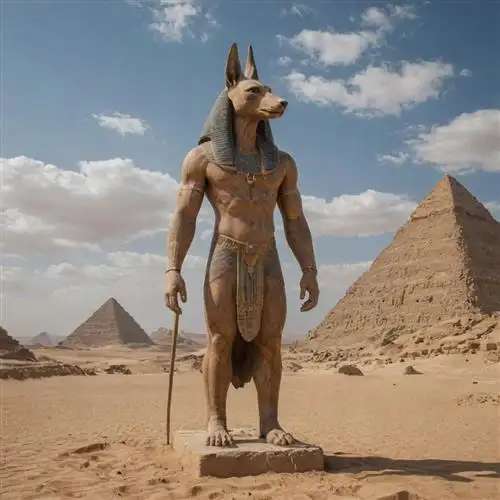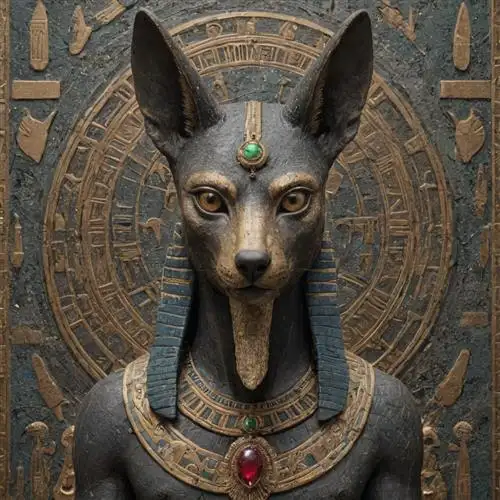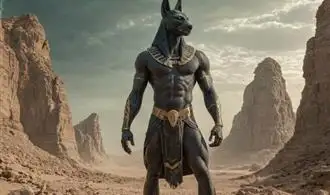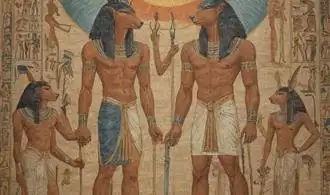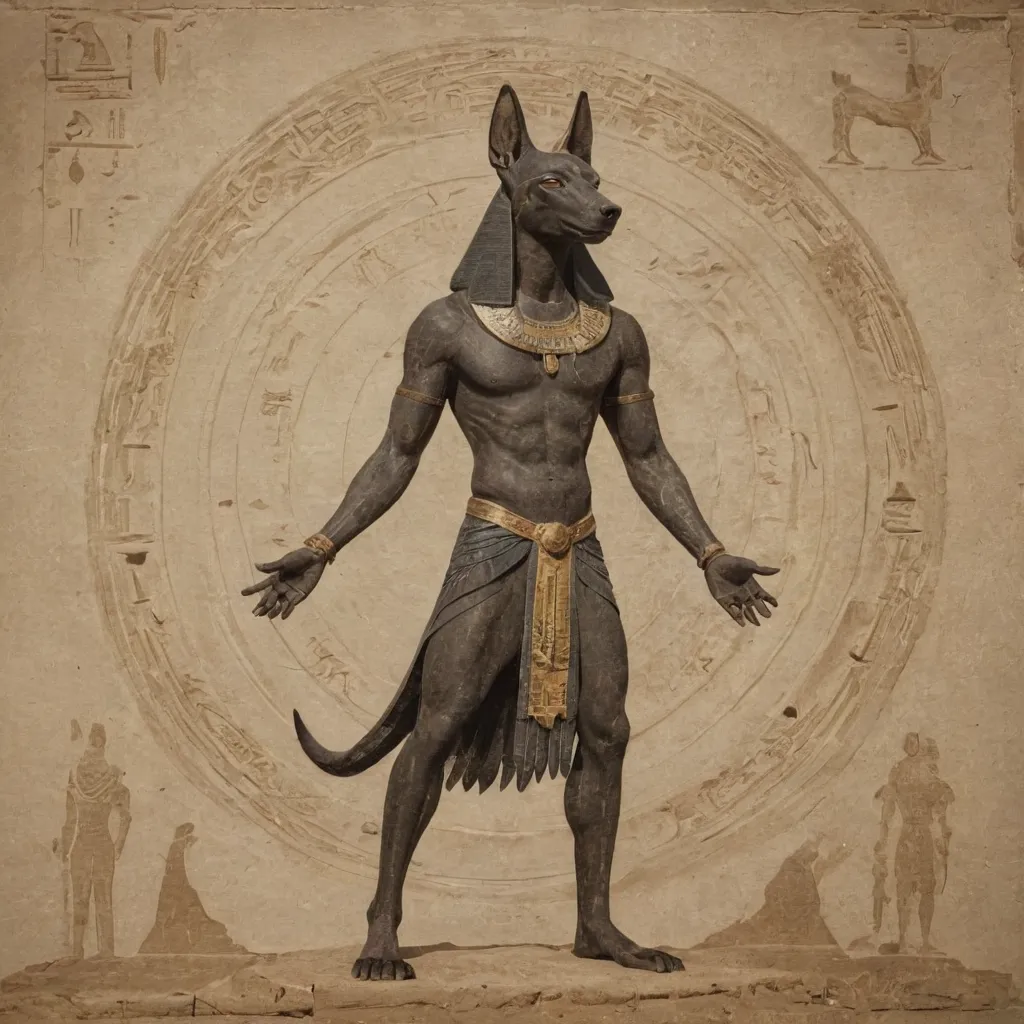
Origins of the Anubis Deity
Anubis, the jackal-headed deity, holds a significant place in the rich tapestry of Ancient Egyptian mythology. Believed to be one of the oldest gods in the Egyptian pantheon, the origins of Anubis can be traced back to the predynastic period, when the jackal was revered as a protector of the dead. As the ancient Egyptians developed their religious beliefs and practices, the role of Anubis evolved, solidifying his status as the god of the dead and the patron of funerary rites.
One of the earliest known depictions of Anubis dates back to the Naqada II period, approximately 3,600 to 3,100 BCE. During this time, the jackal-headed figure was associated with the embalming process, guiding the deceased through the afterlife and ensuring the safe passage of the soul. This connection to the funerary rites and the protection of the dead is a central aspect of Anubis's mythos that persisted throughout the Pharaonic era.
The origins of Anubis's name and iconography are a topic of scholarly debate, with various theories proposed. Some scholars suggest that the name "Anubis" may have derived from the Egyptian word "inpw," meaning "to decay" or "to disappear," reflecting the god's association with the process of mummification and the transformation of the body. Others propose that the jackal-headed figure was inspired by the actual jackal species, which were known to scavenge in cemeteries and were, therefore, seen as guardians of the dead.
Regardless of the exact origins, Anubis's role as the god of the dead and the embalming process was firmly established within the ancient Egyptian religious framework. He was responsible for the mummification of the deceased, ensuring the preservation of the body and the safe passage of the soul to the afterlife. How to Interpret Anubis Depictions Without Making Mistakes provides valuable insights into the symbolism and iconography associated with the Anubis deity.
Anubis's importance in Ancient Egyptian mythology is further underscored by his prominent role in the judging of the dead. In the Book of the Dead, Anubis is depicted weighing the heart of the deceased against the feather of truth, a ritual that determined the worthiness of the soul to enter the afterlife. This process, known as the "Weighing of the Heart," highlighted Anubis's role as a mediator between the living and the dead, guiding the soul's journey and ensuring the preservation of justice and balance in the afterlife.
Anubis Role in the Afterlife
Anubis, the jackal-headed deity, played a pivotal role in the ancient Egyptian afterlife. As the god of mummification and the protector of the dead, Anubis was responsible for guiding the deceased through the intricate rituals and processes necessary for a successful journey to the afterlife.
One of Anubis's primary responsibilities was the embalming and mummification of the dead. He was believed to have taught the art of mummification to the ancient Egyptians, ensuring the preservation of the physical body. This process was crucial, as the Egyptians believed that the soul could not return to the body if it was not properly prepared and preserved.
In the afterlife, Anubis was responsible for weighing the heart of the deceased against the feather of Ma'at, the goddess of truth and justice. This ritual, known as the "Weighing of the Heart," determined whether the individual was worthy of entering the afterlife. Anubis would carefully place the heart on one side of the scale and the feather on the other, ensuring that the scales remained balanced. If the heart was found to be heavier than the feather, representing the individual's misdeeds, they were denied entry to the afterlife.
Anubis also played a crucial role in the funeral procession and burial rituals. He was often depicted leading the procession, guiding the deceased's spirit to the underworld. Additionally, Anubis was responsible for protecting the tomb and ensuring that the deceased's spirit remained undisturbed.
In some ancient Egyptian beliefs, Anubis was even considered the lord of the underworld, responsible for overseeing the entire realm of the dead. In this capacity, he was believed to have the power to grant or deny access to the afterlife, making him a figure of immense importance in the ancient Egyptian cosmology.
Symbolic Meaning of Anubis Iconography
The symbolic meaning of Anubis iconography is deeply rooted in the ancient Egyptian belief system, reflecting the god's multifaceted role in the afterlife and the mummification process. Anubis, often depicted with the head of a jackal or dog, was a central figure in the Egyptian pantheon, responsible for guiding the deceased through the treacherous journey to the afterlife.
The jackal or dog-headed representation of Anubis holds profound significance. Jackals were commonly seen near gravesites, scavenging the dead, and were thus associated with the realm of the dead. This connection to the underworld and the process of death and decay made Anubis the ideal deity to oversee the mummification of the deceased, ensuring a proper and successful transition to the afterlife.
The color black, which often adorned Anubis' iconography, symbolized both death and the fertile soil of the Nile River, which was crucial for agricultural prosperity. This duality represented Anubis' role as the guardian of the dead and the giver of new life, as the deceased would be reborn into the afterlife.
Anubis' scepter, known as the Nekhakha, was a symbol of his authority and power over the funerary rites. This scepter, often depicted in his hands, was a physical representation of his role as the overseer of the mummification process and the guardian of the dead.
The weighing of the heart ceremony, in which Anubis played a pivotal role, was a crucial component of the Egyptian afterlife belief system. During this ceremony, the deceased's heart was weighed against the feather of Ma'at, the goddess of truth and justice. Anubis would oversee this delicate process, ensuring the departed soul's worthiness to enter the afterlife.
Anubis Worship and Rituals
The worship of Anubis, the jackal-headed deity, was deeply ingrained in the religious and cultural fabric of ancient Egypt. As the god associated with mummification, the afterlife, and the protection of the dead, Anubis held a significant place in the pantheon of Egyptian deities. The rituals and practices surrounding the veneration of Anubis were diverse, often intricate, and woven into the very fabric of Egyptian society.
One of the primary ways Anubis was honored was through the practice of mummification. As the deity responsible for the embalming and preservation of the dead, Anubis played a crucial role in the elaborate funerary rites performed by the ancient Egyptians. During the mummification process, the body of the deceased was carefully prepared, and Anubis was invoked to guide and protect the soul's journey to the afterlife.
Temples dedicated to Anubis were found throughout ancient Egypt, serving as hubs of worship and ritual. In these sanctuaries, priests and devotees would engage in various ceremonies and offerings to the jackal-headed god. These rituals often involved the presentation of votive offerings, such as figurines, jars, or other objects, as a means of seeking Anubis's favor and protection.
The importance of Anubis was further cemented in the mythological stories and legends of ancient Egypt. Anubis was believed to weigh the heart of the deceased against the feather of Ma'at, the goddess of truth and justice, to determine the individual's worthiness for the afterlife. This ritual, known as the "Weighing of the Heart," was a critical component of the funerary rites and the journey to the afterworld.
In addition to his role in the afterlife, Anubis was also associated with the concepts of rebirth and transformation. The jackal-headed deity was often depicted guarding the entrance to the underworld, symbolizing his role as a protector and guide for the deceased. This connection to the cycle of death and renewal further solidified Anubis's place as a central figure in the religious beliefs of ancient Egypt.
The worship of Anubis extended beyond the realm of funerary practices and into the daily lives of the ancient Egyptians. Amulets and talismans featuring the image of Anubis were believed to offer protection and guidance, and the deity was invoked in various rituals and magical practices.
The Anubis Iconography - A Beginner's Comprehensive Guide provides a deeper understanding of the visual representations and symbolic meanings associated with the jackal-headed god.
Legacy and Influence of Anubis
Anubis, the jackal-headed deity, held a profound and multifaceted role in the pantheon of ancient Egyptian gods. As the patron of the dead and the embalming process, Anubis's legacy has left an indelible mark on the cultural and religious fabric of this ancient civilization. His influence extended far beyond his primary function as the gatekeeper of the underworld, permeating various aspects of Egyptian belief systems and rituals.
One of Anubis's most significant legacies lies in his association with the mummification and preservation of the deceased. As the deity responsible for the embalming process, Anubis oversaw the careful preparation of the body, ensuring a successful transition to the afterlife. This role granted him immense importance in the Egyptian funerary rites, as the well-being of the deceased was believed to depend on the proper mummification and interment of the body.
Moreover, Anubis's presence in the afterlife was pivotal. He was believed to be the guardian of the scales of justice, presiding over the ritual of the "Weighing of the Heart," where the deceased's soul was judged. This profound responsibility cemented Anubis's position as a crucial figure in the Egyptian concept of the afterlife, guiding the dead through the treacherous journey to the realm of eternal rest.
The iconography and symbolism associated with Anubis have also left a lasting imprint on ancient Egyptian art and architecture. The jackal-headed figure, with its distinct canine features, became a readily recognizable motif in Egyptian artwork, adorning temple walls, sarcophagi, and various funerary objects. This distinctive visual representation further solidified Anubis's place in the collective imagination of the ancient Egyptians.
Beyond his religious significance, Anubis's influence extended to the realm of the living. The deity was believed to provide protection and guidance to the living, particularly in matters of the afterlife and the transition from this world to the next. This belief system integrated Anubis deeply into the daily lives of the ancient Egyptians, cementing his status as a revered and indispensable figure in their pantheon.

